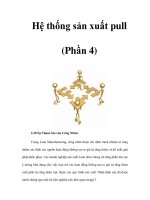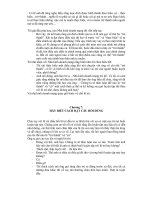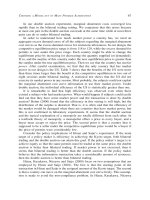Home Made Money PHẦN 4 ppsx
Bạn đang xem bản rút gọn của tài liệu. Xem và tải ngay bản đầy đủ của tài liệu tại đây (69.22 KB, 10 trang )
AARP HOME MADE MONEY | 27
Part 4: Key Decisions
Homeowners seriously considering a reverse mortgage should ask
themselves these key questions:
• Who else should I involve in considering this loan?
• Which counselor should I choose?
• Have I given due consideration to all my choices?
• When would be the best time to take out a reverse mortgage?
• What interest rate should I select?
• Which lender should I choose?
• How should I use this loan?
No one can answer these questions for you. Only you can decide
what’s right for you and your situation. But you need to consider
these decisions carefully, because you will make them one way or
another. And it’s better to do so by thinking them through.
SHARING THE DECISIONS
Who else should you involve in making your decisions about a reverse
mortgage? You may have a trusted friend or advisor who knows your
circumstances — or someone who is generally good at figuring things out or
discussing them with you. You may even want to invite such people to your
discussion with a HUD-approved counseling agency.
On the other hand, you should be cautious of anyone who seems eager for
you to get a reverse mortgage. Be especially alert if that person just happens
to have ideas about what you might do with your loan proceeds. Watch out
in particular for anyone trying to sell you something, or to get your
signature on an agreement to pay them for any purpose.
Remember, we call such people “con men” because they are very good at
gaining our confidence and trust. It’s sad but true that the stranger being so
nice to you may be more interested in your equity than your well-being.
Your Heirs
You also need to think about the impact of a reverse mortgage on your heirs.
A loan with “rising debt and falling equity” means there will be less equity
28 | AARP HOME MADE MONEY
left for your heirs. If you get a lot of cash over many years from the loan,
there may be little if any left for them.
Many children of reverse mortgage borrowers are pleased that their parents
are able to use their equity and remain living in their homes. Often it is a
great relief to these children that their parents are able to take care of their
own needs; many even encourage their parents to do so.
Whether or not you decide to discuss this matter with your children or other
heirs depends on a variety of personal and family factors. You may value
their advice or want to know what they think. Or you may think it best not
to discuss it before making a decision, or not to tell them after you have
closed a loan.
On the other hand, to avoid future misunderstanding, you may want to
make a note of your decision in your will. Whatever you decide, the
important thing is to give some thought to your heirs. A reverse mortgage
can have a substantial impact on your estate. So you need to think through
how you want this to become known to your heirs.
SELECTING A COUNSELOR
To be eligible for a federally insured HECM (Home Equity Conversion
Mortgage), you must discuss the loan with a counselor employed by a
nonprofit or public agency approved by HUD (the U. S. Department of
Housing and Urban Development).
This counseling can be very helpful. So it can be a good idea even if you are
thinking about applying for some other type of reverse mortgage.
To find the HUD-approved counseling agency nearest you call 1-800-569-4287,
or search online at www.hud.gov/offices/hsg/sfh/hecm/hecmlist.cfm/.
National Network Counselors
You may also request HUD-approved HECM counseling through the AARP
Foundation’s Reverse Mortgage Education Project. The Project administers a
national exam for HUD-approved HECM counselors, and the highest
scorers are eligible to participate in a national HECM counseling network.
These counselors are required to use loan analysis and comparison software
that meets the model specifications discussed in Part 2.
Network counselors provide in-person counseling in their local areas, and
counseling by telephone in other areas nationwide. For current information
on requesting HECM counseling services from these counselors, go to
AARP HOME MADE MONEY | 29
www.hecmresources.org/network.cfm or call 1-800-209-8085. This
counseling generally takes at least one hour. When provided by telephone, it
typically requires two or more calls.
Be Prepared
However you request counseling, prepare for it carefully. If you are interested
in a HECM, make certain you are eligible by re-checking the eligibility
criteria in Part 2. Use the calculator at www.rmaarp.com to see if you can
get the amount of cash you need to pay off any current debt on your home,
and for other purposes.
Before requesting counseling, thoroughly consider each of the decisions
discussed in this section. Make a written list of your questions, concerns,
and the additional information you need. Include questions about the
alternatives discussed in Part 3. Ask your counselor to send you loan
printouts in advance so you can review them before your counseling session.
CONSIDERING ALTERNATIVES
Have you carefully considered the main alternatives to a HECM? Have you
seriously looked into the other options discussed in Part 3? If not, you
should do so before applying for a HECM. Even if you end up getting a
HECM, combining it with another option may make more sense than not.
If you plan to sell and move anytime soon, you should consider a home
equity loan and, if you live in one of the few areas that still have them, an
“uninsured” reverse mortgage.
Other Loans
HECMs and proprietary reverse mortgages are most expensive if the loan is
repaid within a few years after closing. These loans typically have substantial
start-up costs, and guarantee that you can stay in your home for as long as
you want. But if you know you are going to sell and move within a few
years, you would be paying for something you are neither expecting nor
likely to need. And that’s generally an expensive thing to do.
If you can qualify for a low-cost home equity loan and easily make the
required monthly repayments, this option can be less costly than a HECM
or a proprietary reverse mortgage. But before applying for a home equity
loan, learn about the potential pitfalls in this market. Search for “home
equity loans” and “predatory lenders” at www.aarp.org.
30 | AARP HOME MADE MONEY
In some parts of Arizona and Massachusetts, you can still get an “uninsured”
reverse mortgage. These loans typically provide monthly advances only, and
they must be repaid in full on a specific date.
These are the only reverse mortgages that do not permit you to remain in
your home for as long as you choose. But if you definitely plan to sell and
move before they become due, these loans may make sense for you.
To the extent that such loans are still available, HECM counselors in these
states generally can help you find them.
Proprietary Reverse Mortgages
If you are considering a proprietary reverse mortgage, you must proceed with
caution.
If your home is worth more than HUD’s 203-b limit in your county, you
might be able to get larger loan advances than you could get from a HECM.
But you are also highly likely to pay more, and you need to understand how
much more these loans can cost.
The best way to compare the costs and benefits of a proprietary plan versus a
HECM is to get the side-by-side loan comparisons produced by software
that meets AARP’s model specifications as discussed in Part 3.
You can get these comparisons from counselors who belong to the national
HECM counseling network described on page 28. The latest information on
obtaining counseling from these counselors can be found at
www.hecmresources.org/requests.cfm.
You can also get these comparisons from some lenders. For the latest
information on lenders who can provide these comparisons, go to
www.aarp.org/revmort/list/ and click on “Selecting a Lender.”
SELECTING A TIME
When would be the best time to take out a reverse mortgage: now or later?
In the future, you may be eligible for larger cash advances because you will
be older and your home is likely to be worth more. If your home’s value is
currently greater than your county’s 203-b limit, that limit is likely to
increase. On the other hand, if interest rates rise, you may not be able get
greater loan advances in the future.
Look at Table 1 in Part 2 or use the calculator at www.aarp.org/revmort to
see how much difference an older age or greater home value could make. The
table also shows you how much difference a higher interest rate could make.
AARP HOME MADE MONEY | 31
If you decide against getting a reverse mortgage at this time, you can still
consider that future possibility as your home equity nest egg. For example, if
you or your surviving spouse lives longer than expected, or if you otherwise
encounter unexpected cash needs, you could consider a reverse mortgage at
that time.
That’s what having a nest egg is all about. You don’t use it till you need it.
But until then, you know it’s there.
SELECTING AN INTEREST RATE
If you are considering a HECM, should you select an interest rate that can
change every year, or one that can change every month?
HECM lenders must offer an interest rate that is tied to the one-year U.S. T-
rate (Treasury Security rate). Once a year, this rate can increase or decrease
by the same amount as any increase or decrease in the T-rate. But this
“annually adjustable” rate cannot change by more than 2 percentage points
up or down per year, nor by more than 5 total points up or down over the
life of the loan.
HECM lenders may also offer a lower “monthly adjustable” rate that can
increase or decrease each month by the same amount as any increase or
decrease in the T-rate each month. But the only limit on this rate is a 10
percentage point cap over the life of the loan.
At present (January 2006), the annually adjustable rate has is 3.1 percentage
points greater than the T-rate. The monthly adjustable rate is 1.5 percentage
points greater than the T-rate. These 3.1% and 1.5% “margins” are set by
Fannie Mae, the company that supplies the money that is lent to you in the
HECM program.
Since the one-year T-rate for January 3, 2006 is 4.37%, the annually
adjustable rate charged on HECM loans is 7.47% and the monthly
adjustable rate is 5.87%.
So the monthly adjustable rate is one and six-tenths of a percentage point
(1.6%) lower than the annual rate.
Monthly versus Annual
The advantages of the monthly adjustable rate are:
• you get larger loan advances;
• when rates fall, your rate will drop sooner than an annually adjusting
rate;
32 | AARP HOME MADE MONEY
• your rate will be lower than an annually adjusting rate for as long as
increases in the T-rate are less than 3.6 percentage points per year or 6.6
points over the life of the loan; and
• your rate can decrease by more than 2 points per year, and by more than
5 points over the life of the loan.
How much greater would the loan advances be when selecting a monthly
versus an annually adjusting interest rate? On January 3, 2006, a 75-year-old
single borrower living in a $250,000 home could have gotten a creditline of
about $127,000 from an annually adjustable HECM versus about $157,500
from a monthly adjustable HECM.
The main advantage of the annually adjustable rate is that a lower interest
rate will be charged on your loan balance whenever T-rate increases are greater
than 3.6 points per year or 6.6 points over the life of the loan. Also, when
rates increase, your rate will not rise as soon as a monthly adjusting rate will.
Which rate should you select? It depends on how much you value the extra
cash you could get with the lower, monthly adjustable rate. It also depends
on what you think may happen to interest rates. How likely do you think it
is that future T-rate:
• increases will be greater than 3.6 points in a given year, or 6.6 points
over the life of the loan; or that
• decreases will be greater than 2 points in a given year, or 5 points over
the life of the loan?
During the 1990s, the difference between the lowest and highest one-year T-
rate on a weekly basis was about 5.5 points. But for the previous decade, that
difference was about 11.5 points.*
Most HECM borrowers select a monthly adjustable rate, no doubt because
they prefer the greater cash advances and the lower initial rate. Some may
also believe the T-rate is unlikely to exceed the annual rate’s caps for any
extended time. Others may prefer the larger advances even if they believe
that rising interest rates may cost them more.
Borrowers selecting an annual rate are generally concerned that rising rates
might exceed the annual rate’s caps for extended periods. Without the
protection of these caps, they fear, their loan balances will grow faster, so there
may be a lot less equity left for them or their heirs when the loan is over.
*Source: Federal Reserve Bank
of New York
AARP HOME MADE MONEY | 33
SELECTING A LENDER
The most complete lists of HECM lenders can be found online at
www.hud.gov/ll/code/llplcrit.html/. Enter your city or select your state,
place a checkmark in the “HECM” box, and click the “SUBMIT” button.
But which lender should you use to get a HECM loan? You need to consider
cost, origination services, loan servicing, and a lender’s professional
commitment to meeting consumer needs.
Cost
Generally the only HECM loan costs that lenders control are the origination
fee and the servicing fee. So be sure to find out the dollar amount that each
lender you are considering would charge you for these fees. Although third-
party closing costs are not likely to vary much from lender to lender, you
might want to check these as well.
At present, HECM interest rates do not vary from one lender to another
(unlike traditional mortgages). The rates can change each week, but during
any given week, every HECM lender charges the same rates. This could
change in the future, however. So check out the latest information at
www.aarp.org/revmort.
Origination Services
The level of service a lender provides may be more difficult to assess than
cost is, but service can be important. You will want your loan officer to be
knowledgeable, experienced, and respectful.
After reading this booklet, you will be better able to gauge how well a lender
knows reverse mortgages. How long a lender has been offering HECMs and
in how many places may be particularly important if your loan runs into any
unexpected snags.
An experienced lender has already encountered most of the issues that can
cause problems, and is most likely to have a good working relationship with
the nearest HUD office.
You will also want a loan officer who respects your knowledge and
preferences and helps you reach your own decisions. Pressure sales tactics are
a sure sign that a lender is more concerned about selling you a loan than
meeting your needs.
34 | AARP HOME MADE MONEY
Loan Servicing
At loan closing, most originating lenders transfer their loans to another office
or company specializing in servicing the loan from that point forward. Ask
each lender: “Who will service my loan after it closes?”
Request a sample of the account statements the servicer would send you.
Make certain you fully understand all the information on these statements.
In particular, if you are considering a HECM creditline, find out how the
servicer would keep you informed about the growing amount of credit a
HECM provides (see Part 2).
Professional Commitment
A commitment to meeting consumer needs can be seen in a lender's
professional relationships and consumer information.
For example, members of the NRMLA (National Reverse Mortgage Lenders
Association) have developed “best practices” for their industry. For more
information, go to www.reversemortgage.org.
If you don’t want to be contacted by a NRMLA lender, however, be sure to
state that preference if you request any NRMLA publications. Lenders
committed to the highest standard of consumer information can provide
loan analyses and comparisons that meet AARP’s model specifications as
discussed in Part 2.
For the latest information on lenders who can provide this type of consumer
information, go to www.aarp.org/revmort. But please note that AARP does
not endorse any reverse mortgage product or lender.
SPENDING YOUR EQUITY
How much of your available loan amount would you take as a lump sum, as
a creditline, or as a monthly advance? For what reasons would you take
withdrawals from a HECM creditline?
You need to consider these questions carefully, especially if your home equity
is one of your few financial assets. Very simply, the more equity you use now,
the less will be left in the future. If you spend all your equity too soon, it
may become financially difficult for you to remain living in your home.
On the other hand, if you have to move due to disability or failing health,
you would need to pay for the cost of moving, future living expenses, and
possibly assisted living or other types of care. So the amount of equity
remaining at the end of your loan could be vitally important to you.
AARP HOME MADE MONEY | 35
Leftover Estimates
HECM counselors and lenders can estimate how much equity would be left
at various future times based on assumptions about future interest rates, your
loan advances, and about changes in your home’s value.
These estimates generally assume that your home would be sold to repay the
loan. So they deduct the estimated cost of selling your home from your
remaining equity.
Then it’s a simple calculation: If the estimated net sale proceeds are greater
than your estimated debt, you (or your heirs) would get the difference in a
lump sum of cash. If at any point your rising debt catches up to your home’s
value, then there would be no equity left.
Estimate Shortcomings
Unless your counselor or lender uses computer software based on AARP’s
model specifications, the leftover estimates they provide may have
shortcomings similar to the ones discussed in Part 2 about TALC rates.
Most reverse mortgage borrowers select a creditline. The amount of leftover
equity at the end of a creditline loan depends primarily on the size and
timing of the cash advances a borrower requests during the loan.
Computer software based on the model specifications lets you enter the
creditline draws that you expect to make. This gives you a more accurate
estimate of the equity that would remain if your loan were to end at various
points in the future. Other loan software may not permit you to see how
your expected creditline draws would affect your remaining equity.
Other loan software may also assume that the initial interest rate charged on
your loan will never change. But that may be unlikely after a time of
relatively low interest rates (January 2006). So this assumption may
overestimate your future leftover equity.
Software based on the model specifications lets you select the interest rate
used to estimate your leftover equity. So you can choose a higher rate than
the one that is initially charged on your loan.
By varying these factors, you can see how much effect each can have on your
leftover equity. You should remember, however, that all of these figures are
estimates. The actual figures will depend on
• the actual creditline advances you select during the loan;
• the actual interest rates charged on the loan; and
36 | AARP HOME MADE MONEY
• the actual changes in your home’s value during the loan.
Creditline Growth
Most HECM borrowers put all of their available cash into a creditline. So it’s
important to be able to see how creditline withdrawals affect the growing
amount of credit available from a HECM.
The calculator at www.rmaarp.com can show you the effect of various
creditline withdrawal patterns on a year-by-year basis. To see them, run the
calculator and then on the “Loan Calculator Estimates” page click on the
“Creditline” button toward the bottom of the page, and follow the
instructions.
Computer software based on AARP’s model specifications can also show the
effect of different creditline withdrawals on your future loan balance, total
amount owed, and total annual average loan cost.
If you take a HECM creditline, keep an eye on its growth. Being aware of
how much cash remains in your creditline and the rate at which it is growing
will help you make decisions about making cash withdrawals.
Remember, you can control the amount of credit that remains in your
account. The less cash you take out now, the more will remain for later. It
doesn’t make much sense to set up a creditline and then not use it. But you
should also avoid using too much too soon.
For example, if you spend all the cash in your creditline, will you still be able
to pay your property taxes and homeowner’s insurance? If you fail to make
these payments, and there is no cash left in your creditline, a HECM lender
can foreclose on your loan. Just like with a forward mortgage, if you do not
pay your property taxes and insurance, you could lose your home.
So be certain to leave enough cash in your creditline to pay your
taxes and insurance if you do not have other funds available for
this purpose.
Investing
Investing the money you get from a reverse mortgage is a highly
questionable practice. It is extremely unlikely that you could safely earn
more from an investment than the loan would cost.









